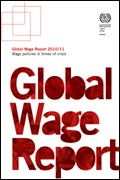Studies in this week’s Hutchins Roundup find that minimum wage increases do not pass through to prices, US debt limit impasses in Congress raise the cost of borrowing for the federal government, and more.
Want to receive the Hutchins Roundup as an email? Sign up here to get it in your inbox every Thursday.
Minimum wage increases do not pass through to prices
Although much of the minimum wage debate centers on the effects of minimum wage increases on employment, an increase in the minimum wage might also lead to higher prices by increasing labor costs or by increasing incomes and, thus, demand. Sharat Ganapati and Jeffrey Weaver of Yale conclude that minimum wage increases have no economically significant effect on the prices of food purchased at grocery stores and wholesale clubs, a sector that is particularly important for households in the lowest income quintile. They explain that this very weak pass-through stems from the fact that low-wage labor accounts for only a very small share of costs in this sector. They find that minimum-wage labor is a small share of costs in all sectors other than restaurants and fast food. They conclude that minimum wage increases will have almost no effect on prices in most sectors.
US debt limit impasses raise borrowing costs for the Treasury
In the summer of 2011 and the fall of 2013, impasses in Congress over raising the debt limit meant that the federal government was in danger of defaulting on its debt. Such a default would mean that payments to investors with interest or principal due right after the date of default would be delayed, but might also lower confidence in the financial system more broadly. David Cashin, Erin Syron Ferris, Beth Klee, and Cailey Stevens of the Federal Reserve Board find that, during these debt limit episodes, yields on all Treasury securities—even those unlikely to be affected by any payment delay—rose by 4 to 8 basis points, suggesting a “financial contagion” effect. The authors estimate that the rise in yields raised Treasury borrowing costs by roughly $250 million during each episode.
Land use restrictions in high productivity US cities lowered growth by half over the last several decades
Cities such as New York and San Francisco that experienced the highest labor productivity growth over the past few decades also adopted restrictions on new housing construction, driving up housing prices and preventing workers from other areas from moving to take advantage of the higher productivity. Using data from 220 US metropolitan areas, Chang-Tai Hsieh of the University of Chicago and Enrico Moretti of the University of California, Berkeley find that such land use restrictions lowered aggregate GDP growth by about 50 percent between 1964 and 2009.
Chart of the week: The value of the US dollar is back to where it was before the elections

Quote of the week: “If all goes well, the Bank of Japan’s current policy framework may yet be sufficient to achieve the inflation objective,” says Ben Bernanke.
“We’ll have to wait and see. If not, there are relatively few options available. The most promising possibility—should we get to that point—is more explicit coordination of monetary and fiscal policies. Monetary policy that is aimed at limiting the impact of fiscal expansion on the government’s debt could both make fiscal policymakers more willing to act and increase the impact of their actions. The BOJ may be reluctant to take such a step. In the possible future state that I am contemplating, however, there would be no real alternative other than to abandon the fight to raise inflation and, perhaps, even to accept a new bout of deflation. After such a long and valiant effort to end deflation and raise interest rates from their effective lower bound, that would be a most disappointing outcome.”









Commentary
Hutchins Roundup: Minimum wage, debt limits, and more
Thursday, May 24, 2017